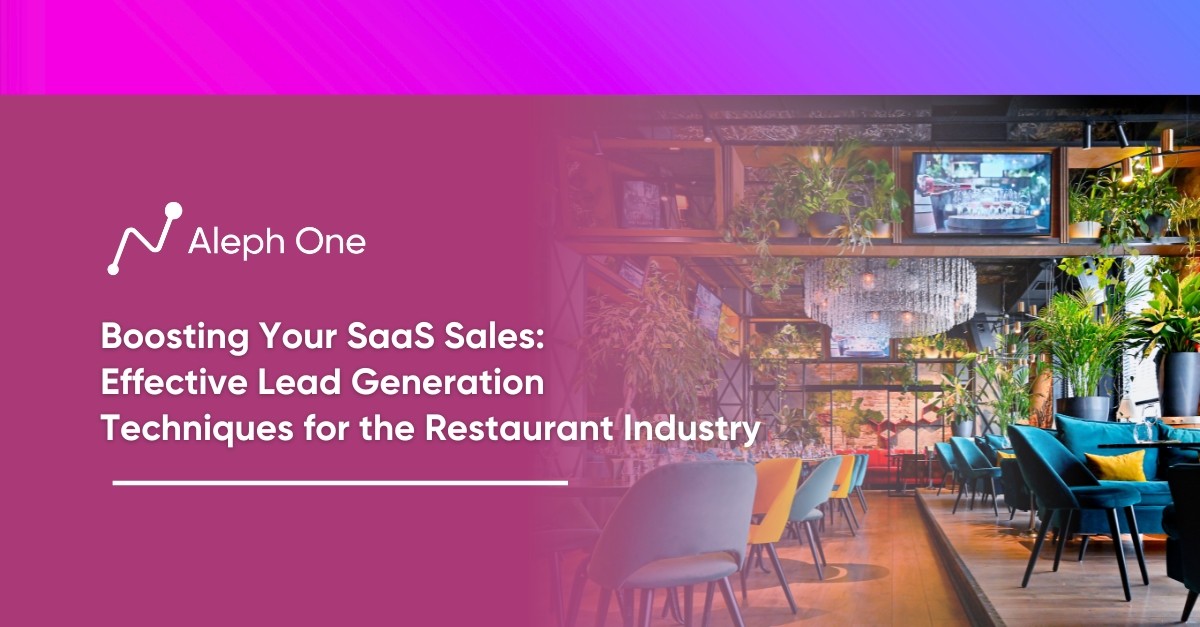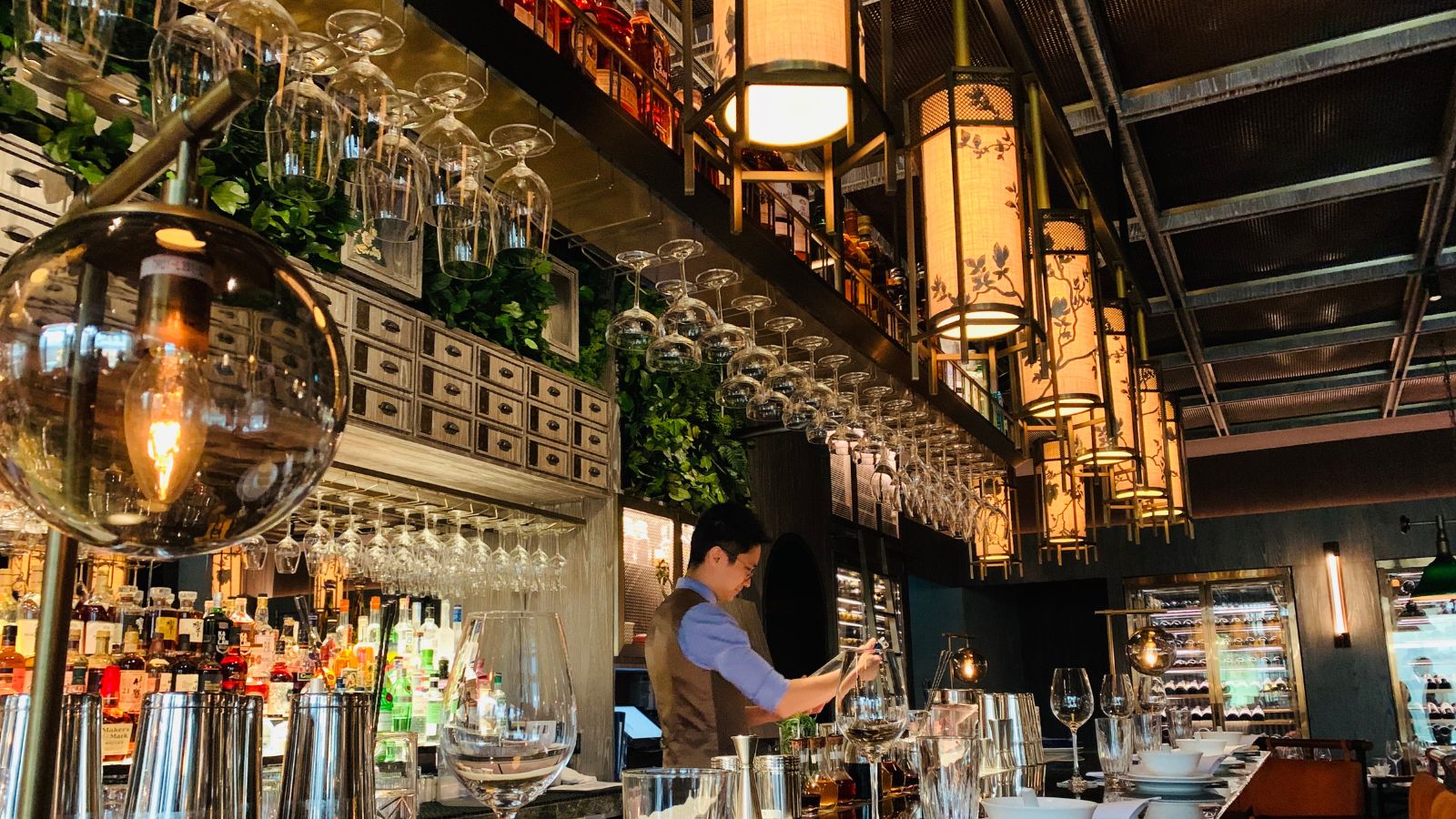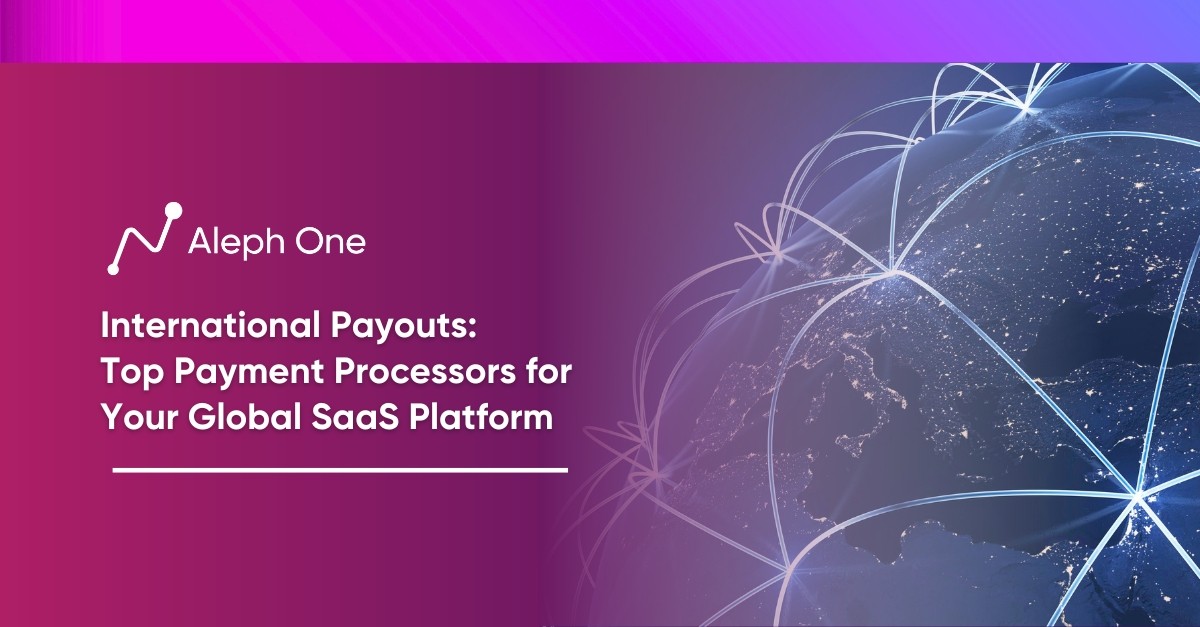Let’s work together to build something amazing. Share your project details and our team will reply to figure out the next steps to your success.

The restaurant industry has undergone a technology revolution in the past decade, embracing software as a service (SaaS) tools to enhance operational efficiency and improve the customer experience. With the rise of smartphones and the increasing importance of online reviews, the adoption of mobile-friendly SaaS solutions for online ordering, reservations, and payment processing has become widespread. Additionally, cloud-based point-of-sale systems have streamlined operations, while review monitoring and response tools have helped manage restaurant reputations. As the industry embraces SaaS solutions, it presents a significant opportunity for lead generation and sales. This article explores effective lead-generation techniques for the restaurant industry, including content marketing, social media engagement, email marketing, SEO and PPC strategies, and the power of networking and industry events.

The Rise of SaaS in the Restaurant Industry: How Did We Get Here?
Over the past decade, the restaurant industry has experienced a technological revolution. Restauranteurs have adopted software as a service (SaaS) tools at an incredible rate to help them run their businesses more efficiently and improve the customer experience. According to research from Statista, the restaurant tech industry has grown at an annual rate of nearly 20% since 2011 and is now worth over $200 billion.
Mobile-friendly SaaS Solutions
The rise of smartphones drove much of this change, as restaurant owners sought to meet customers where they were—on their mobile devices. This led to the rapid adoption of mobile-friendly SaaS solutions for online ordering, digital reservations, mobile payments, and more. Today, most full-service restaurants offer online reservations, and many fast-casual brands allow customers to order takeout or delivery through a mobile app.
Point-of-sale (POS) Systems Transitioning to Cloud
Point-of-sale (POS) systems have also transitioned to the cloud, allowing restaurant staff to spend less time manually entering orders and more time focusing on the customer experience. Modern POS systems integrate with other back-office tools for inventory, staff management, and accounting. One survey shows 63% of restaurants now use cloud-based POS solutions.
Online Reviews and Ratings
Another driving force behind the growth of SaaS in the restaurant industry has been the increasing importance of online reviews and ratings. Many restaurants now use SaaS review monitoring and response tools to manage their reputations. Research shows that over 90% of diners read online reviews before choosing a restaurant, so these tools have become essential for reputation management and customer acquisition.
Restaurants have adopted SaaS solutions at a rapid pace to keep up with trends in mobile technology, digital payments, cloud computing, and online reviews. For SaaS companies targeting the restaurant industry, this widespread adoption of software tools represents a huge opportunity for lead generation and sales.
Content is King: Creating Valuable Resources for Your Target Customers
In today’s digital world, creating helpful and informative content is one of the best ways to generate new leads for your SaaS product. For the restaurant industry, content like blog posts, guides, checklists, and videos that provide actionable tips and advice for restaurant owners and managers are particularly effective. This content should focus on the key challenges and pain points you know restaurants face and how your product helps solve them.
Video Content
For example, a blog post on “5 Ways to Increase Customer Loyalty Through Better Online Reviews” or an “Optimizing Your Restaurant Floor Plan for Higher Revenue” checklist would provide value to your target customers. Video content is also popular, as many people prefer to consume information visually. A video on “3 Common Mistakes Restaurant Owners Make with Their Data and How to Fix Them” may resonate well.
SEO
All of this content should be optimized for search engines like Google so that when your potential leads search for this information, your content ranks at the top of the results. This is known as search engine optimization or SEO. Using essential keywords in your title, headings, and content; including internal links between your content; earning high-quality backlinks; and encouraging social shares are some of the best ways to improve your SEO.
Social Media
You should promote this content on your company’s website and blog on social media platforms like Facebook, Instagram, and LinkedIn. When potential leads find and read your helpful content, they will see your company as a valuable resource for their business. And when the time comes for them to invest in new software, your product will be at the top of their list.
Creating a content marketing strategy focused on educating your target audience is the foundation for lead generation for SaaS businesses. For the restaurant industry, content that provides actionable tips and advice for challenges like improving customer loyalty, optimizing floor plans, making data-driven decisions, and more will position your company as a trusted partner and source of leads.
The Power of Social Media: Engaging Your Community
Social media platforms like Facebook and Instagram have become essential for restaurants to connect with customers and generate new leads. According to recent studies, over 70% of restaurants consider social media an integral part of their marketing strategy. With millions of foodies and aspiring chefs active on social media, these channels offer restaurants unparalleled opportunities to raise brand awareness, promote new menu items, and engage directly with their community.
Behind-the-scenes Photos and Videos
One of the most effective social media lead-generation techniques for restaurants is to post behind-the-scenes photos and videos of your culinary team in action in the kitchen. These authentic glimpses into the work that goes into creating a dish or meal help to build a personal connection with your followers. You can also run social media contests and giveaways, such as offering complimentary appetizers or gift cards in exchange for liking and sharing a post. Tagging followers who promote your contest in your posts is an easy way to make them feel appreciated while exposing their networks to your brand.
Engage With Followers and Community
Social media’s key is broadcasting promotions and updates and engaging with your followers and community. Like and comment on your followers’ posts, especially those who post photos of enjoying a meal. Respond to comments and messages from followers promptly and personally. Ask open-ended questions in your posts to encourage discussion. This genuine social interaction and word-of-mouth marketing are invaluable for lead generation.
For restaurants, Instagram, in particular, has become a vital platform for sharing visually stunning images of food, cocktails, and your reliance. With over 1 billion monthly active users, most under 35, Instagram should be a key focus of your social media lead generation efforts. Posting drool-worthy photos of your signature dishes and drinks is the best way to capture the attention of food-loving Instagram users and inspire them to become new customers.
An active and engaging social media presence is essential for boosting your SaaS sales in the restaurant industry. When done well, social media lead generation through platforms like Facebook and Instagram can help to build buzz, raise brand visibility, and keep your restaurant at the top of customers’ minds.
Email Marketing: How to Stay in Touch with Your Leads
Email marketing is one of the most effective techniques for generating new leads and staying connected with existing customers for SaaS companies in the restaurant industry. Building an email list of people interested in your product or service and sending regular newsletters and promotions is a proven way to boost sales.
Build Your Email List
To build your email list, offer something of value to your target audience, like an ebook, white paper, or free trial of your software, in exchange for their email address. You can also ask people to subscribe on your website, at events, or through social media. The key is making it easy for people to opt in with a simple form on your site. According to recent research, the restaurant industry has an average email open rate of over 20%, higher than many other industries.
Types of Emails to Send to Customers
With a strong list, you must send valuable and engaging emails consistently. A good rule of thumb is sending 2-4 emails per month. Some types of emails to consider include:
- Newsletters: Share recent blog posts, new feature updates, case studies, and other company news. A monthly or quarterly newsletter is a great way to stay top of mind with leads and clients.
- Promotions: Highlight sales, discounts, or special offers to generate new leads and upsell existing customers. Time these around major holidays for the best results. But only send a few promo emails, which can lead to lower open rates.
- Surveys: Ask your readers for feedback on their challenges, how they use your product, new features they’d like to see, etc. Surveys are a great way to strengthen customer relationships and gain valuable insights.
- Event invitations: Let your email list know about any industry events, webinars, or conferences you will attend or sponsor. This raises brand awareness and allows people to connect with you in person.
- Case studies: Share stories of how other restaurants have succeeded using your SaaS solution. Case studies build trust in your product and motivate new leads to sign up for a trial.
Using a combination of these email types, you can stay in regular contact with your leads and clients, generate new sales, upsell existing customers, and strengthen your brand in the restaurant industry. An active email list gives you a powerful tool for boosting your SaaS sales.
Getting Found Online: Why SEO and PPC Matter for Restaurants
In today’s digital world, most people first turn to the internet for a new restaurant or tools and services to help run an existing restaurant. Having an effective online presence is crucial for lead generation. Search engine optimization (SEO) and pay-per-click (PPC) advertising are two of the most essential strategies for getting found online.
SEO Helps Rank Your Website & Content
SEO refers to optimizing your website and content so that you rank higher in the organic or unpaid search results on Google and other search engines. For restaurants, this means having a mobile-friendly website, creating content about your cuisine, services, and location incorporating important keywords, earning high-quality backlinks from other sites, and encouraging happy customers to leave reviews on your Google Business Profile and sites like Yelp or TripAdvisor. Ranking higher in search results leads to more visibility and traffic to your website, which translates to more leads.
PPC Benefits for Restaurant Advertising
PPC advertising allows you to pay to have your ads appear at the top of search results when people search for terms related to your business. For example, a restaurant SaaS company could bid on keywords like “restaurant reservation system” or “restaurant management software.” When someone searches for those terms, your ad will appear at the top of the results page. The most popular PPC platforms are Google Ads and social media advertising on platforms like Facebook, Instagram, and LinkedIn. While PPC does require paying for each click, it allows you to get very targeted with your lead generation.
SEO, PPC strategy, and high-quality website are the foundation for any digital marketing effort. An estimated 77% of diners search online for restaurants in the restaurant industry. Being found online through search and social media is critical to reaching new potential customers and generating leads for your SaaS business in today’s competitive market. By optimizing your online presence, you can connect with more of your target leads and drive more sales.
Making Connections: Networking and Events
While digital marketing techniques are essential for lead generation, in-person connections remain extremely valuable. Networking and attending industry events are opportunities to build relationships that could lead to new clients. For SaaS companies in the restaurant industry, sponsoring or attending major restaurant conferences and trade shows is a must.
National or Regional Events
Look for well-attended national or regional events in your area of focus, like the National Restaurant Association Show or Restaurant Leadership Conference. Sponsoring these events is a great way to raise your brand visibility if the budget allows. At a minimum, attend to connect with current and potential new clients. Walk the floor, visit other vendors, and strike up conversations. Come equipped with a strong pitch about your product or service and a compelling reason why attendees should connect with you after the event.
Follow Up With Potential Customers
Follow up within a few days with anyone who expressed interest in your product. Send a personalized email reintroducing you and your company. Ask open-ended questions to start a dialogue and look for opportunities to provide value, such as offering a product demo or trial. These post-event communications are a chance to build rapport and stay on attendees’ radar.
Word-of-mouth Marketing
Word-of-mouth marketing from your happy clients continues to be one of the most effective lead-generation techniques. Ask your clients if they would be willing to provide a testimonial for your website or marketing materials. They may also be open to an introduction to others in their network. While you never want to pressure clients to provide referrals, letting them know you are actively looking to help other restaurants through your product or service may inspire them to suggest you to peers they think would benefit.
Real-life Interactions & Recommendations From Industry Insiders are Invaluable
Making in-person connections at events and nurturing relationships over time through follow-up and referrals require effort and resources. However, in an increasingly impersonal digital communication age, these networking and word-of-mouth marketing techniques can set you apart and lead to more sales in the long run. For SaaS companies in the restaurant industry, real-life interactions and recommendations from industry insiders are invaluable for establishing credibility and trust with potential new clients.
FAQ
What are the primary reasons for the rapid adoption of SaaS solutions in the restaurant industry?
The primary reasons for the rapid adoption of SaaS solutions in the restaurant industry are the rise of smartphones and mobile technology, the transition to cloud-based point-of-sale (POS) systems, and the increasing importance of online reviews and ratings for reputation management and customer acquisition.
How can a content marketing strategy benefit SaaS companies targeting the restaurant industry?
A content marketing strategy can benefit SaaS companies targeting the restaurant industry by providing value to their target audience, building trust, and positioning them as trusted partners and sources of leads. Content that provides actionable tips and advice for challenges like improving customer loyalty, optimizing floor plans, making data-driven decisions and more will resonate with restaurant owners and managers and establish a strong connection with potential customers.
What are some effective social media lead generation techniques for restaurants?
Some effective social media lead-generation techniques for restaurants include posting behind-the-scenes photos and videos of the culinary team in action, running contests and giveaways, tagging and engaging with followers, asking open-ended questions to encourage discussion, and sharing visually appealing images of signature dishes and drinks on platforms like Instagram. These techniques can help build brand awareness, promote new menu items, and establish a genuine connection with the restaurant’s community, increasing foot traffic and sales.
Get the latest news and updates from Aleph One in your inbox.



